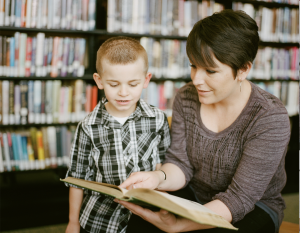Top 8 Ways to Protect Your Kids Online and Improve Communication in the Family
 As a middle school teacher, I constantly have parents come to me and ask if I would be willing to impose a rule for my class that students cannot use social networking sites like twitter, Snapchat, Instagram, or any of those types of social networks at home, because they don’t want to be the bad guys with their teens and say “no.” It always makes me chuckle, because the only area I can really have any control over is inside my classroom during school hours. I don’t get to drive home with their kids and spend time in the evenings with them; it’s not my job to enforce boundaries at home. But just the same, parents continue to roll in each week with the same requests about how uncomfortable they are with enforcing the rules for their kids when other kids are allowed to freely roam social networking and cell phone applications until the wee hours of the morning. The other concern I hear from parents is in understanding what the programs even do or how to keep their kids safe in such an evolving and changing, connected and technological world. Since so many parents have come to me with similar concerns and requests, I decided to do some of my own research on what I could give parents as a guide to help them feel a little less overwhelmed by the never-ending, ever-expanding digital world. I have come up with eight ways to help keep kids/teens safe on digital devices that will also aid in lessening parents’ anxiety around being seen as “bad guys.” I am no expert about digital technology but have found, as a teacher and school counselor, that these suggestions have been helpful with communication and have been basic steps in keeping my students and clients safer, while they are at school.
As a middle school teacher, I constantly have parents come to me and ask if I would be willing to impose a rule for my class that students cannot use social networking sites like twitter, Snapchat, Instagram, or any of those types of social networks at home, because they don’t want to be the bad guys with their teens and say “no.” It always makes me chuckle, because the only area I can really have any control over is inside my classroom during school hours. I don’t get to drive home with their kids and spend time in the evenings with them; it’s not my job to enforce boundaries at home. But just the same, parents continue to roll in each week with the same requests about how uncomfortable they are with enforcing the rules for their kids when other kids are allowed to freely roam social networking and cell phone applications until the wee hours of the morning. The other concern I hear from parents is in understanding what the programs even do or how to keep their kids safe in such an evolving and changing, connected and technological world. Since so many parents have come to me with similar concerns and requests, I decided to do some of my own research on what I could give parents as a guide to help them feel a little less overwhelmed by the never-ending, ever-expanding digital world. I have come up with eight ways to help keep kids/teens safe on digital devices that will also aid in lessening parents’ anxiety around being seen as “bad guys.” I am no expert about digital technology but have found, as a teacher and school counselor, that these suggestions have been helpful with communication and have been basic steps in keeping my students and clients safer, while they are at school.
#1: Have your kid’s passwords to his or her social network accounts
Your kids need to allow you to be their “friend” and accept you to their social media accounts. This is not so you can spend hours spying on them, or ruining their lives (like you really have the time for obsessing and following your kid’s every thought), but instead it is to ensure you have access if a time came when something went wrong and you needed to find out what is going on or where your child/teen is.
Teens tend to express what they are feeling online through social network sites—you want to be aware of where they are at and to be able to check in if they are acting strange or emotionally off. You can see what they are sharing and with whom, and also if there is any bullying or if any threats are taking place.
By the way, it is important to remind your kids that what they write is public. If they are not willing to say it to you, their parent, then it is probably best unsaid in such a public arena (or not sent visually as a picture either). The main purpose of having access to their social network accounts is to keep your kids as safe as you can. If the worst case scenario were to happen and they made a bad decision and went to meet someone they didn’t know from online (which happens more then you would think), you could easily track them down with no time wasted.
#2: Install a Parental control on internet websites at home to help stop exposure to sex, violence and other subjects that are inappropriate for your kid’s age.
 No parent wants to find out that his or her child has been pre-maturely exposed to extreme sexual content or violence because they were searching the Internet for a word they had heard but didn’t know what it was. Kids are curious and constantly exploring and learning—and it is exactly what they should be doing as they grow. The Internet is a really big multidimensional encyclopedia for all of the questions kids have. If you search the word “boob” or “sex” the hits and links that come up can get pretty crazy, pretty fast. These questions and curiosities are not the problem. However, the immediate and extensive information that is produced from typing in such innocent words can be very scaring and traumatic for your kid when he or she is exposed to some of the visuals, videos and other language that comes from the links.
No parent wants to find out that his or her child has been pre-maturely exposed to extreme sexual content or violence because they were searching the Internet for a word they had heard but didn’t know what it was. Kids are curious and constantly exploring and learning—and it is exactly what they should be doing as they grow. The Internet is a really big multidimensional encyclopedia for all of the questions kids have. If you search the word “boob” or “sex” the hits and links that come up can get pretty crazy, pretty fast. These questions and curiosities are not the problem. However, the immediate and extensive information that is produced from typing in such innocent words can be very scaring and traumatic for your kid when he or she is exposed to some of the visuals, videos and other language that comes from the links.
I have a friend whose 7 year-old son typed in “boob” and the first link took him to a page that talked about the term “titties.” He then typed in “titties” and was taken to a porn site with mom’s lactating, which then had other words that he then began to search. In the time of three links, he was being exposed to things he never wanted to know about or could even comprehend or understand at his age. He was wracked with feelings of guilt, shame and confusion when he talked to his mom about it.
Support your kids’ innate curiosity to learn but keep them safe from exposure to material that can be inappropriate and traumatizing by protecting them from the get-go through a “net-nanny” type of service. There are a lot of different brands and companies doing this out there. I am no expert on what program works best or not—I just suggest looking into finding one that works for your family’s needs.
#3: Designate a “Screen Time” location at home.
Have a specified location in your home for your kids to use their computers and other digital screens where you can see their screens or monitor—like the living room, dinning room or office space. Don’t let them go into their rooms and close the door with full access to the internet by themselves.
At bedtime it can be helpful to have a public spot in the house where all devices are stored and charged while everyone sleeps. This helps reduce the impulse to go back on the computer or cellular device after going to bed. I work with a lot of teens who come into school pretty tired and when I ask them why, they say they were up late playing games or watching Netflix or going on social networking sites. When they couldn’t fall asleep, they went on after their parents went to bed to kill the time. This is very common in the teens I work with—especially boys wanting to play games into the night. Gaming gives your brain a ton of dopamine, which is the brain chemical that makes you feel good (rewards you), therefore, it can become quite addictive for physical reasons. Help your teen get good healthy rest since their impulse control is compromised because their pre-frontal cortex, which is in charge of monitoring impulsivity, is not fully developed. Encourage them to read a book, listen to calming music, or write if they can’t sleep.
#4: Have clear printed up expectations and rules for Screen Time and use of digital devices for your family that all of you can agree on. Keep this visible in the house.
PUT IT IN WRITING. Once you have established what your family is comfortable with for screen time, put it in writing and post it in on the walls of the house where devices are used. Let your kids know what you expect clearly, verbally and in writing. Since we all learn differently, it is good to present expectations in multiple styles—visually, orally, and experientially (by doing it.)
CONSEQUENCES. Decide what your family’s consequences are for breaking these expectations, or any of the others mentioned in this article. A good example of one is taking away the device for the rest of the day/evening. This consequence is effective yet sensitive because it does not need to be shaming or loud. By just quietly taking away the device, the consequence is immediately felt without negative reinforcement of any kind. “Ok, we will try again tomorrow. Love you.” If your child cries or has a fit, let them but don’t be swayed by their reaction. Walk away or send them to their room and allow them go through their emotions; this is part of their learning process.
#5: Place time limits on screen time (this helps reduce anxiety/addiction behaviors)
 It can really help your kid/teen to know what their limits are in regards to screen time. This is something every family needs to figure out on its own, but some suggested limits to add would be to turn off all devices an hour before bedtime. This allows the brain to unwind and begin to relax for going to sleep. Studies have shown that people who go to bed right after using technology tend to have less deep restorative sleep (less REM) time. Relaxing music would be fine—but the end of the day is time to “unplug” from the constant need to be connected to the network of friends and media. So figuring out what time is bedtime and turning off cell phones, computers, and other devices—including TV’s–can really help your kid/teen stay healthy in the long run.
It can really help your kid/teen to know what their limits are in regards to screen time. This is something every family needs to figure out on its own, but some suggested limits to add would be to turn off all devices an hour before bedtime. This allows the brain to unwind and begin to relax for going to sleep. Studies have shown that people who go to bed right after using technology tend to have less deep restorative sleep (less REM) time. Relaxing music would be fine—but the end of the day is time to “unplug” from the constant need to be connected to the network of friends and media. So figuring out what time is bedtime and turning off cell phones, computers, and other devices—including TV’s–can really help your kid/teen stay healthy in the long run.
#6: Check Privacy settings on gaming sites and video game consoles that connect to the internet (This especially applies with boys who are into gaming).
One of the biggest areas that kids and teens (especially boys) are being exposed to sexual predators is through gaming networks, which do not have privacy settings. People pose as younger kids/teens and, because they can engage in conversation with on a headset or by typing, they talk dirty and sexually to kids while gaming. This makes anyone you don’t know in real life, or through a friend in real life, a possible offender and you probably shouldn’t trust them to be safe. Make sure you kids know that if anyone ever asks them to meet up, to tell you right away. Be sure that they understand the importance of never giving out any personal information like address, phone, birthday, full name, or location.
It is also important to help your child/teen set-up privacy settings fro all their social networking applications and programs. If it stays open to public eyes then your child/teen is a sitting duck waiting for a predator to take a look. One teenage girl I worked with at a high school in town had a Facebook account which she had not set up with private viewing “friends only,” and a man found her online and posed as a 17-year-old boy at another school. When this girl would post her location and what she was doing “I’m at the movie theater watching “Divergent” at 2:00pm” This man would follow her to the locations and watch her . He even started to talk to her but she didn’t know how he knew whom she was.
One day a close classmate of this girl called her mom and told her that her daughter was planning on going on a date with this boy she had never met and that she felt like he may be weird or not good due to some things expressed on social networking sites. Her mom luckily was one of her “friends” on her social networking sites and went on to check on her and noticed she was going to meet this “teen” for a date after school that day. Her mom called the school and had them follow her to the curb where her “friend” was picking her up supposedly since she had lied to her mom about where she was going and then drove to the school as soon as she could. She warned them that she thought this guy may be a sexual predator due to some of the info gathered from the friend and his Facebook page. When the “teen boyfriend” from Facebook pulled up, it was a 45-year-old registered sex offender ready to pick her up. The school had already called the cops and the man was arrested. The girl recognized the man and had realized he had been following her around town by watching her posted locations on her cell phone accounts and her Facebook. This is why it is important to set up privacy settings and to encourage your kids to only become friends with people they have met in person already. Also, never post specific information about where you are located or where you are planning on going with times and locations. Keep that info private.
#7: Never give away personal information and Help Teach Your Kids this.
What personal information am I referring to?Name, phone number, birth date, activities and locations you will be taking part in with a date and time. In #6 I explain the reason for this suggestion.
#8: Everything you write and say is permanent when using digital media and devices.
If you wouldn’t say it out loud in front of your grandparents or parents, don’t say it and send it digitally. We recently had an officer come and talk about digital safety online in my Life Skills Class at Santa Barbara Middle School. She explained that there is no such thing as privacy or the ability to erase what you share digitally permanently. What I mean by this is that when you write something on Facebook, or another social media site online—even if you delete what you wrote or your entire Facebook or other account-it may disappear for public view but it is stored and kept on a server, which is accessible in legal matters later. It never goes away.
This is true about cell phones as well. If you text someone something (like a photo or something you wrote when you were being reactive) and you delete it—it actually never goes away fully. If you got in trouble with the law or someone reported you—all of your texts (deleted or saved) are accessible by the phone company and the cops or court can get access to them. They are permanent and can get you into a lot of trouble if you are not being conscious and aware of what you are writing and sharing via your cell phone. This is very important for kids to know and learn about because impulse control is much lower in the pre-fontal cortex of a kid/teen.
#9: Sleep over’s with friends.
Make sure to check in with the other kid’s parent’s rules and supervision around technology. Make it clear to them about your own rules and ask for them to respect that while your kid is there. Respect other parents request for stricter monitoring if they ask. Communicate with other parents and see what issues or concerns they have. You can help each other make rules and expectations be about safety—not control or being “mean.” Uniting together as a group of parents will bring strength to it.
 A few weeks ago my 13-year-old niece who lives with us full time, invited three friends to spend the night at our house. I met with the girl’s parents ahead of time and discussed their policies around electronics, what ratings on movies they can watch and any concerns I should make sure to keep an eye on around digital media. One of the parents brought up that at a past sleep over at anther girl’s house her daughter and her friends got into trouble after 11:00pm with Instagram, Snapchat and texting on their cell phones. She said that she found that most the trouble with social media had been happening after 9:30pm and that she found it best to just take away cell phones after 9:30pm at sleep over’s. This was a great observation and expectation to express I thought. It is now also one of our house rules. If you really think about it, what does a teenager need to share or do after 9:30pm at night other then getting ready for bed or actually talking and socializing with the real live people who are sleeping over without the aid of technology. Some healthy real people time to communicate.
A few weeks ago my 13-year-old niece who lives with us full time, invited three friends to spend the night at our house. I met with the girl’s parents ahead of time and discussed their policies around electronics, what ratings on movies they can watch and any concerns I should make sure to keep an eye on around digital media. One of the parents brought up that at a past sleep over at anther girl’s house her daughter and her friends got into trouble after 11:00pm with Instagram, Snapchat and texting on their cell phones. She said that she found that most the trouble with social media had been happening after 9:30pm and that she found it best to just take away cell phones after 9:30pm at sleep over’s. This was a great observation and expectation to express I thought. It is now also one of our house rules. If you really think about it, what does a teenager need to share or do after 9:30pm at night other then getting ready for bed or actually talking and socializing with the real live people who are sleeping over without the aid of technology. Some healthy real people time to communicate.
I also can tell you that our niece was not a “happy camper” and did not accept this new rule with ease. A mini tantrum and some pouting. “You ruined our sleep over!” Dramatic but very normal for this age group, (I have worked as a middle school teacher for 13 years), so we were happy to see she was behaving in the correct developmental stage for her age. The next day she was still a bit frustrated at us. Now she has accepted it and actually can see how it helped her and her friends talk and be with each other more in person. Plus, we as her guardians, could go to sleep with a peace of mind knowing she and her friends would be safe (the most trouble they could get in was spilling milk on the floor or talking too loud into the night, which we encourage as healthy kids need to do!)
A Note on Boundaries and Conflict with Your Teen Around Digital Technology:
Boundaries as a parent are one of the things that can cause a lot of conflict at first but in the end you are actually helping your kids feel safe. It means you are taking care of them, keeping them safe, and it gives your teens (especially) a reason to tell their friends they can’t talk or interact without being the one’s being mean to their friends (instead their parents are at fault). Kids don’t always know how to ask or stop for quite time for themselves to rest and recharge. In limiting and or setting boundaries around media connection you are helping your teen learn the benefits of disconnecting. It may not feel like they are appreciative of your “no” but in the long run and underneath it they will be. Saying “no” doesn’t mean you’re being mean, instead it mean’s “I love you.”
Tags: child care, child-rearing, children, good parenting skills, internet, kids, online, parenting, parenting advice, parenting skills, parenting tips, parents, teach kids, teachers, teaching kids, technology, teenagers, teensOne Comment
Comments are closed.









Thank you Caroline